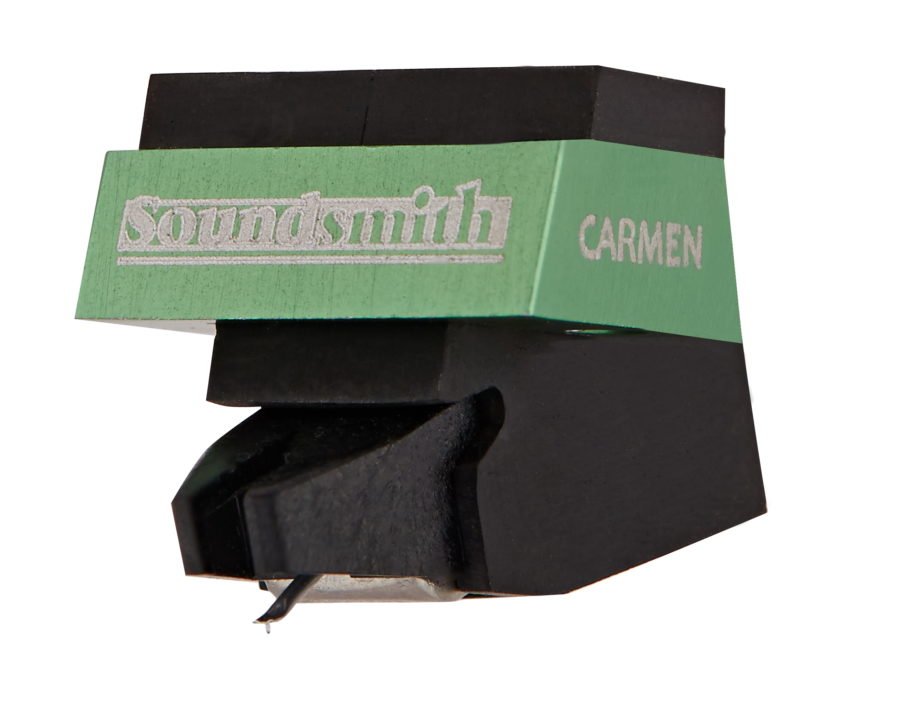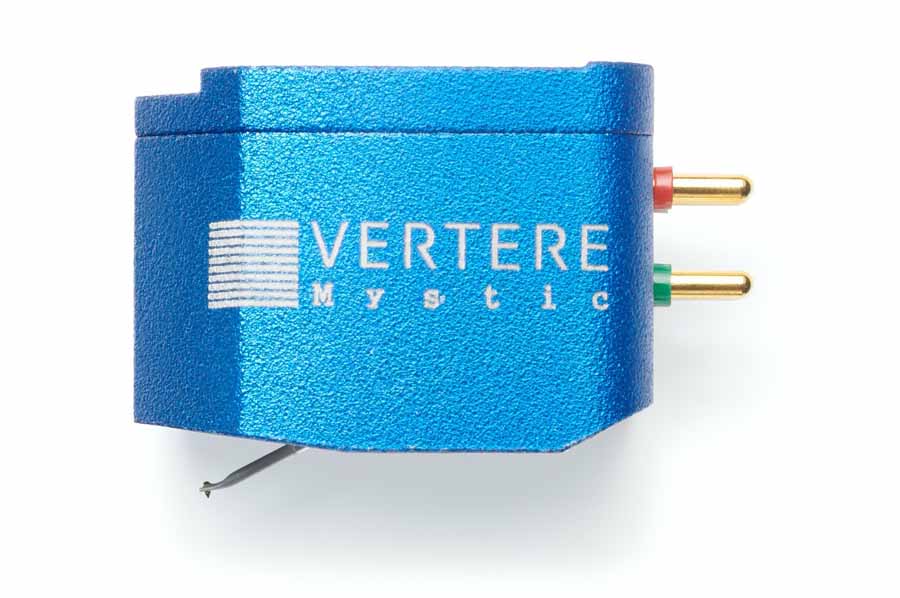Janine Elliot takes a listen to the Soundsmith Carmen Moving Iron Cartridge that is made in the US and costs £759.00.
My own collection of Cartridges has morphed from Ceramic to Magnetic, to MM, MI and MC. Then along came Soundmith, one of those companies you wish you had always known. When I first heard their SG-200 I saw the light, not least because of the two LED’s glowing to show power was getting to the cartridge. The Strain Gauge cartridge is like no other cartridge. Instead of inducing a signal voltage by motion by coils or magnets, the Strain Gauge cantilever movement deflects two minute silicon strain gauge elements. The blue lights are there to tell you that all is OK, and they are not electrostatic cartridges aka Stax of old, that some may have thought. And where the Strain Gauge’s much reduced effective moving mass means a quicker and tireless response, the ‘Carmen’ up for review here uses their Moving Iron topology which means no heavy coil or magnet having to move about. Instead, a tiny ultra-low mass high-purity moving iron element wiggles about between an area of fixed coils and permanent magnets. This means an effective tip mass of only 0.35g, and me setting my Rega 301 arm to 1.4g on my Townshend Rock 7. Whilst the design has a fixed permanent stylus assembly similar to that on a moving coil cartridge, it actually needs to be fed to the Moving Magnet input of your phono-stage, if you have a choice.
The relatively high output is due to the fact that the stationary magnet/coil structure can be made large, and therefore also allow for a lower vertical tracking force of between 1.2 and 1.4g. All in all this lack of mass improves the cartridge’s transient response and its agile ‘trackability’. All is assembled in an ebony enclosure to “enhance the performance” with a distinctive green body to distinguish it from all the others in the range. Whilst most of engineer and designer Peter Ledermann’s cartridges require hefty cheque books, the Carmen, the replacement for their esteemed SMMC3, is a song at £759.00, being one of the cheapest in the range, from a company set up in 1972 and based in Peekskill, about an hour away from New York.
Where Panasonic produced Strain Gauge cartridges long before Soundsmith did, so too B&O made Moving Iron cartridges, and it was Ledermann’s interest in those and his request to the Scandinavian company to use their technology long after they had chucked out their own tooling that paved the way to making Soundmith products. The company even offers re-tipping or replacing of B&O cartridges. The similarity between the two companies then becomes apparent if the SMMC3 acronym hadn’t already given it away; the indented shape of the front of the cartridge body that when looked at from above shows the stylus tip was something that I liked about the original B&O MMC 1- 5. Finding your way to the start of a groove is a doddle, rather than the guesswork from most cartridges with the stylus hidden somewhere underneath the body. Bang and Olufsen’s cartridges used a cross-shaped piece of ultra-low-mass high purity iron (MMC stands for Moving Micro Cross), and the Soundsmith MI designs use stationary coils and magnets and a small piece of “moving iron”.
With over 60 cartridges to his name, Ledermann is no slouch. In his career he has been a design engineer at RAM Audio Systems, working with Richard Majestic on the designs of everything from high-power, minimal-feedback power amplifiers and preamplifiers to phono stages. He was also a senior research engineer at IBM with 11 patents to his name. As a result of his diverse experience in audio design his talents at Soundsmith extend to the CDT-4 automated audio tester, phono preamplifiers, a zero feedback MOSFET power amp and speakers. He even services major brands such as Revox, Bang & Olufsen, Nakamichi, and Tandberg.
Sound
The Carmen MI cartridge was a doddle to set up on my arm and matching the 47K Ohm and 100pF load gave a smooth, velvety, if slightly prominent midrange, but covering the entire frequency range with good bass and clean top end, and a pace and rhythm that made for detail and beauty. All was there, and I did feel that some of the crackles from worn discs paled into insignificance as the music came out, which was a pleasant outcome. My Love Song “Feel the Love” live album has a beautifully engineered drum kit and audience sound, and the Soundsmith kept the gig alive, with each instrument clearly placed on the stage, and vocal warmth that made the music quite relaxed but not slow nor losing detail, and well, very pleasant. Even the applause sounded like applause rather than rain on the caravan roof. Everything sounded exact, but for me just a little too tame. My Yes “Live from House of Blues” 180g three-LP set is one of those albums that can cause headaches on even the best set ups. Whilst I love Jon Anderson’s velvety voice I really do need to be in the right mood to listen to anything other than ‘The Messenger’ or ‘Nous Sommes Soleil’, but putting it with the Carmen was like ‘strawberries and cream’ (or in my case ‘cheese and marmite’). This just jelled so well that I had to play the whole set. The Carmen has a velvety property of its own, making music of all kinds just so sweet. It wasn’t slow; that lightweight frame puts that out of the question, as it allows the music to flow with nothing getting in the way. My ancient RCA Camden Classics Shostakovich Symphony No.5, conducted by Howard Mitchell, gave all instruments their own place in the soundstage, though it sounded somewhat slower than I was used to. Dmitri Shostakovich called this symphony a “Soviet Artist’s reply to just criticism”, complaining that his music could still be popular to the mass audience. The Soundsmith could justly be considered as a US engineer’s reply to those who think cartridges only work with certain types of music. This beauty just made everything sound good, with only a slight mid frequency emphasis that spoilt my listening at times. Vocals should of course work well with any cartridge named after an opera, just as the Aida, Boheme, Otello, or any of the other opera or vocal inspired names from this company should also do. That mid-lift through my Wilson Benesch/Krell setup was minimal, but through my original 1970’s Chartwell LS3/5a and Slee setup this was a more pronounced, even compared with my choice Kontrapunkt b. However, the idea of a low mass, low playing weight cartridge was for me very appealing. At 6.8g it is 2/3 the weight of my Ortofon, and plays at half the tracking force. All this means an agility and control that made me favour those high compliance cartridges back in the 80’s. Whilst this cartridge can be classed as medium-compliance, when I connected to my aged SME3/Transcriptors Hydraulic reference system, suddenly the sound opened up in a way that felt more relaxed and open. Whilst most UK and US magazines esteemed the SME 3 back in the 1980’s it has unfortunately been culled as the pink elephant of the SME brand over the years, mainly because it was only designed for high-compliance, low tracking weight MM cartridges, but also largely because of magazine politics. The SME 3 always gave a smooth and musical, almost reel-to-reel sound, and my Shure V15iv cartridge works wonders on it. I didn’t think I would be able to better this, but with the Carmen this was done quite significantly. Had I still got my SME Series 2 arm I would have tried that too, as I am sure that would have worked even better, being medium compliance. But, to play at 1.2g on my SME3, Transcriptors, Slee and Chartwell LS3/5a set up was a breath of fresh air and I didn’t want to remove the cartridge and return it. Funny world.
Back to the 21st Century, the Carmen has a nude elliptical 6 x 17 μm stylus on an aluminium alloy cantilever with reasonable 26dB channel separation at 1kHz and a MM/MI class’ output voltage of 2.12mV. When a (very) young child I assumed that cartridges might go up in value as they have diamonds, and as cartridges go, whilst they might not be as collectable or look as much a jewel on the crown as the Koetsu’s of the world, the complete set from Soundsmith certainly look better than most of the cartridges out there, with their distinctive colours and precious stone colour effects. Whilst the colour includes to some extent their sound, I did not find this a hindrance but actually to add to my enjoyment of the music, and in a way wasn’t a million miles from that from a Koetsu.
Conclusion
For those wanting a £4000 Sussurro but don’t have the money, the Carmen gets pretty close for considerably less. With its ultra-low moving mass, reasonably high output and low vertical tracking force, this is a cartridge you should have a listen to.
For those who want a sensual, intuitive and detailed sound this cartridge should be just what you are asking for.
Agility, control and musicality
Velvety flavour to the sound
Lightweight
High output for MM phonostage
Can be rebuilt over and over for 20% of retail price, even if not the original owner
Price
Cons:
The warm velvety sound might to too coloured for some
Slightly enhanced mid-band might not suit everyone.
Price £759
Janine Elliot
| Technical Specifications | |
| Stylus | Nude Elliptical, 0.120mm SQ |
| Radius of curvature | 6 x 17 µm |
| Cantilever | Aluminum Alloy |
| Recommended Tracking force: | 12mN / 1.2 gm (high) 14mN / 1.4 gm (medium) |
| Effective tip mass | 0.35 mg |
| Compliance | 28 µm/mN (high) 22 µm/mN (medium) |
| Frequency response | 20-20,000 Hz ± 2.5 dB |
| Channel Separation (stereo only) |
1000 Hz >26 dB 50-15,000 >20 dB |
| Channel difference | <1.6 dB (Stereo) <1.0 dB (Mono) |
| Output @ 5 cm/sec. | >2.12 mV |
| Retipping Cost | $250 |
| Cartridge weight | 6.8 grams |
| Load: | Resistance >/= 47 kohms
Capacitance: 100 – 200 pF (400-600 pf available by special order) |





































































































































































































You must be logged in to leave a reply.